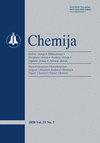1-(4-取代苯基)-5-氧代吡咯烷-3-甲酰肼衍生物的合成及其抗菌活性研究
IF 0.4
4区 化学
Q4 CHEMISTRY, MULTIDISCIPLINARY
引用次数: 0
摘要
酰肼是合成多种衍生物(包括在药物设计和发现中具有生物学意义的杂环化合物)的重要前体。人们发现,以吡咯、噻吩、呋喃、喹啉、异喹啉、异噁唑和苯并咪唑为结构核心的酸性酰肼可用于医学、药学、农业和许多其他领域。为了寻找具有抗菌特性的化合物,本研究使用单酰肼和二酰肼来制备 1-(4-取代苯基)-5-氧代吡咯烷-3-甲酰肼衍生物,这些衍生物带有相应的腙和唑取代基。目标化合物是通过与所选芳香醛和异靛红的缩合反应生成的,缩合反应生成了相应的腙类结构,而与二酮的缩合反应则生成了具有吡唑和吡咯核的化合物。此外,还使用革兰氏阳性枯草杆菌和革兰氏阴性大肠杆菌菌株对合成的化合物进行了初步抗菌评估。正如预期的那样,评估揭示了潜在的候选抗菌物质,有助于应对抗生素耐药性和传染病爆发的全球性挑战。本文章由计算机程序翻译,如有差异,请以英文原文为准。
Synthesis and investigation of antibacterial activity of 1-(4-substituted phenyl)-5-oxopyrrolidine-3-carbohydrazide derivatives
Hydrazides are very important precursors for the synthesis of a wide variety of derivatives, including heterocyclic compounds of biological interest in drug design and discovery. Acid hydrazides with a pyrrole, thiophene, furan, quinoline, isoquinoline, isoxazole and benzimidazole core in the structure were found to be used in medicine, pharmacy, agriculture and many other fields.
In the search for compounds with antibacterial properties, mono- and dihydrazides were used in this study to prepare 1-(4-substituted phenyl)-5-oxopyr-rolidine-3-carbohydrazide derivatives bearing the corresponding hydrazone and azole substituents.
The formation of the target compounds was performed via condensation reactions with the chosen aromatic aldehydes and isatin, which led to the construction of the appropriate hydrazone-type structures as well as with diketones which afforded compounds with pyrazole and pyrrole nuclei.
In addition, a preliminary antibacterial evaluation of the synthesised compounds was performed using the gram-positive Bacillus subtilis and the gramnegative Escherichia coli bacterial strains. As it was expected, the evaluation revealed potential antibacterial candidates that can help address the global challenges of antibiotic resistance and infectious disease outbreaks.
求助全文
通过发布文献求助,成功后即可免费获取论文全文。
去求助
来源期刊

Chemija
化学-化学综合
CiteScore
1.30
自引率
16.70%
发文量
14
审稿时长
>12 weeks
期刊介绍:
Chemija publishes original research articles and reviews from all branches of modern chemistry, including physical, inorganic, analytical, organic, polymer chemistry, electrochemistry, and multidisciplinary approaches.
 求助内容:
求助内容: 应助结果提醒方式:
应助结果提醒方式:


